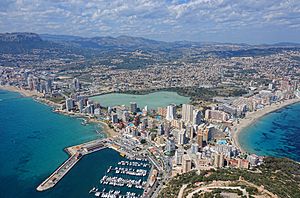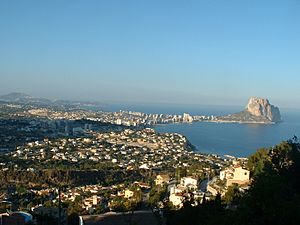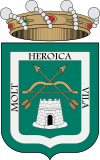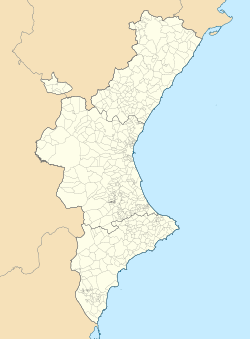Calpe facts for kids
Quick facts for kids
Calpe
Calp
|
||
|---|---|---|

Calpe seen from Pico de peñón de Ifach
|
||
|
||
| Country | Spain | |
| Autonomous community | Valencian Community | |
| Province | Alicante | |
| Comarca | Marina Alta | |
| Area | ||
| • Total | 23.51 km2 (9.08 sq mi) | |
| Elevation | 59 m (194 ft) | |
| Population
(2022)
|
||
| • Total | 24,096 | |
| • Density | 1,024.93/km2 (2,654.5/sq mi) | |
| Demonym(s) | Calpí, calpina | |
| Time zone | UTC+1 (CET) | |
| • Summer (DST) | UTC+2 (CEST) | |
| Postal code |
03710
|
|
| Official language(s) | Valencian, Spanish | |
Calpe (also called Calp) is a beautiful coastal town in Spain. It's located in the Alicante province of the Valencian Community, right by the Mediterranean Sea. Calpe is known for its stunning natural landmark, the Penyal d'Ifac Natural Park, a huge rock that rises from the sea.
The town covers about 23.5 square kilometers and had a population of 24,096 people in 2022. Calpe's main activities are tourism and fishing. You can find many old sites from Iberian, Roman, and Arab times here. This is because its location by the sea was very important for trade and travel long ago. Did you know the Prime Meridian line crosses right through Calpe?
Contents
What is Calpe's History?
Calpe has a very long history! People have lived in this area since prehistoric times, even as far back as the Bronze Age. The first proper buildings were made by the Iberians. They built their homes on higher ground for safety.
Ancient Times: Iberians and Romans
The giant rock, Penyal d'Ifac, was like a natural watchtower. People could see far and wide from there. Another important lookout spot was Morro de Toix Mountain. From here, they could control the Mascarat Ravine, a key passage along the coast.
The area became even more important when the Romans arrived. Being close to the sea was great for trading by boat and for fish factories. You can still see evidence of this at a historical site called Els Banys de la Reina (the Queen's Baths).
Medieval Times: Arabs and Aragonese
After the Arabs took control of Spain, they built a castle overlooking the Mascarat Ravine. Later, when the Crown of Aragon conquered the area, they kept the Arab way of organizing towns. Small towns were protected by a castle or fortress. The people of this region depended on the Castle of Calpe.
In 1290, a leader named Roger of Lauria took control of Calpe. He ordered a new village called Ifach to be built near the Rock of Ifach. But in 1359, a war between two kings, Peter IV of Aragon and Peter I of Castile, destroyed Ifach. This led to more people moving to the Alqueria, which was a small, simple rural building.
In 1386, the area around the Castle of Calpe was divided. This created the towns we know today as Benissa, Teulada, Calpe, and Senija.
Pirate Attacks and Growth
In 1687, something scary happened: Barbary pirates attacked Calpe! They captured 290 townspeople and took them to Algeria. These people were held prisoner for five years. They were finally freed in exchange for gold and the release of some pirate prisoners. At that time, Calpe had only 18 houses inside its castle walls and about 350 people.
During the 17th century, Calpe's population grew. This helped the town become more stable. By the mid-18th century, the town needed new walls because so many people lived outside the old ones. In the 19th century, Calpe grew towards the west, following the main road between Altea and Alicante.
Modern Calpe: Fishing and Tourism
In the second half of the 19th century, the fishing industry really took off. Buildings like the Fisherman's Cooperative were built. Salt production also restarted in 1918 after the El Saladar salt flats were cleaned up. Better fishing boats were built thanks to new technology.
The first small hotels started appearing around Els banys de la Reina and Racó Beach. These catered to people who were starting to take summer holidays. Tourism really grew with the building of the Ifach Parador hotel in 1935.
After 1945, many holiday villas and small hotels were built. This was to welcome the growing number of summer tourists. Most hotels were built right on the coast. In the late 1960s, Calpe, like other places on the Costa Blanca, saw a huge building boom. This was due to changes in politics and the rise of tourism for everyone. Calpe even became a filming location for Spanish film director Jesus Franco in the late 1960s and early 1970s!
What Can You See in Calpe?

Calpe has many interesting places to visit:
- The ruins of Els banyas de la reina (the queen's baths).
- The flooded salt flats, which are a special bird sanctuary for birds that migrate.
- A beautiful Gothic Catholic church.
- The old 18th-century tower of La Peça.
The Penyal d'Ifac Natural Park is also a very popular place for tourists to visit. It's great for hiking and enjoying nature.
Twin Towns
Calpe is connected with other towns around the world. These are called "twin towns" and they often share cultural exchanges. Calpe is twinned with:
 Oppenheim, Germany
Oppenheim, Germany El Puerto de Santa María, Spain
El Puerto de Santa María, Spain
See also
 In Spanish: Calpe para niños
In Spanish: Calpe para niños





